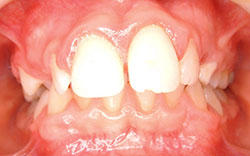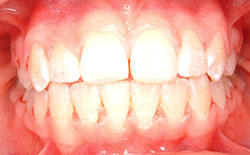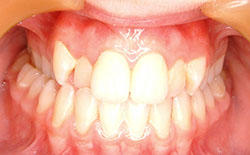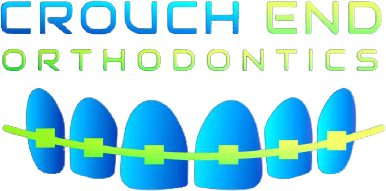Orthodontic Disorders
Orthodontic Disorders
(Malocclusions)
Protruded (stick out) upper front teeth - Increased Overjet
Protruded upper front teeth (where the upper front teeth extend too far forward) are more prone to trauma and fracture. This condition often indicates an imbalance in jaw growth, typically involving a smaller lower jaw. Thumb and finger sucking habits can also contribute to the protrusion of the upper front teeth.*
Orthodontists commonly refer to this condition using the term “overjet.” Overjet describes the horizontal distance between the upper and lower front teeth — specifically, how far the upper front teeth extend beyond the lower front teeth. A normal overjet is approximately 2–3 mm. When the overjet exceeds 6 mm, the risk of dental trauma increases significantly. In cases of excessive overjet, the upper front teeth may even protrude ahead of the lower lip.
*An investigation into the association between facial profile and maxillary incisor trauma, a clinical non-radiographic study (Dent Traumatol. 2010;26(5):403-8.)
*The association between orthodontic treatment need and maxillary incisor trauma, a retrospective clinical study (Oral Surg Oral Med Oral Pathol Oral Radiol Endod. 2011;112(6):e75-80.)
Before & After
Increased Overjet-London
Increased Overjet-London

Before

After

Before

After
Crowded teeth
Crowding or having crooked teeth, is probably the most common reason to seek orthodontic treatment. Crowding occurs when teeth haven’t got enough space to erupt and have abnormal positions such as overlapping or displacement in various directions. This can be because there is not enough room for the teeth, the teeth are unusually large, or the jaw is small or narrower than it should be. Severe crowding may indicate removal of adult teeth to straighten the teeth.
Non-extraction orthodontic treatment, which is promoted by some dentists, raises certain concerns. These include the risk of dehiscence (thinning of the alveolar bone) caused by excessive expansion that pushes the teeth outside the supporting bone. In cases where the teeth are crowded, this can lead to unsightly gingival recession and receding gums. Additionally, there are limitations in fully correcting severe malocclusions without extractions. For example, a patient with severely protruded or proclined upper and lower teeth would not achieve an ideal treatment outcome with non-extraction therapy.
Before & After
Crowded teeth London
Crowded teeth London

Before

After

Before

After
Crossbite
A crossbite occurs when the upper teeth sit inside the lower teeth. Crossbites can make it difficult to bite or chew properly and, over time, can lead to abnormal tooth wear. In the presence of a crossbite, patients often shift their lower jaw forward (in the case of an anterior crossbite) or to the side (in the case of a posterior crossbite), which can result in functional problems and jaw discomfort over time.
Before & After
Crossbite-London
Crossbite-London
Crossbite-London

Before

After

Before

After
Underbite
A crossbite of the front teeth, commonly called a reverse bite, is referred to as an underbite when the lower front teeth sit in front of the upper front teeth. This is typically seen in Class III malocclusions, where the patient has a protruded lower jaw. In severe cases, underbites may require surgical correction as part of comprehensive orthodontic treatment. Among patients undergoing jaw surgery (orthognathic surgery), the majority present with Class III malocclusions.
Before & After
Underbite-London
Underbite-London
Underbite-London

Before

After

Before

After
Deep overbite or deepbite
Overbite refers to the vertical overlap of the maxillary central incisors over the mandibular central incisors. The normal overbite is about 2-3 mm, or approximately 20-30% of the height of the mandibular incisors.

A deep overbite, often referred to as a ‘deepbite,’ occurs when the upper front teeth (incisors) overlap excessively over the lower teeth, sometimes nearly hiding the length of the lower incisors. In cases of complete deepbite, the biting edges of the upper teeth may come into contact with the lower front gum tissue, and the lower front teeth may bite into the roof of the mouth. If left untreated, this can lead to gum tissue damage.
Before & After
Deepbite-London
Deepbite-London
Deepbite-London

Before

After

Before

After
Class lll Malocclusions, Reverse Bite
A reverse bite, or Class III bite, can affect the way you chew and is more common among Asian populations. The following are some adult cases successfully treated by removing two premolars in the lower jaw or without any extractions.
Severe Class III cases may require surgical correction, and nearly half of the adult cases requiring jaw surgery present with Class III malocclusions. For some of the milder cases, we can use TADs (Temporary Anchorage Devices) or mini-implants to correct the malocclusion without the need for surgery.*
*An Objective Assessment of Orthognathic Surgery Patients. J Craniofac Surg. 2019 30(8):2479-2482.
*Orthognathic Surgery Treatment Need in a Turkish Adult Population: A Retrospective Study. Int. J. Environ. Res. Public Health 2019;16, 1881.
*A retrospective analysis of dentofacial deformities and orthognathic surgeries. Annals of Maxillofacial Surgery 2017;7(1); 73-77.
*Functional needs of subjects with dentofacial deformities: A study using the index of orthognathic functional treatment needs (IOFTN). Journal of Plastic, Reconstructive & Aesthetic Surgery 2016;69(6):796–801.
*A retrospective analysis of dentofacial deformities and orthognathic surgeries using the index of orthognathic functional treatment need (IOFTN). International Journal of Pediatric Otorhinolaryngology 2015; 79(7):1063-1066.
*A retrospective investigation of orthognathic patients and functional needs. Australasian Orthodontic Journal 2024;40:111–120









